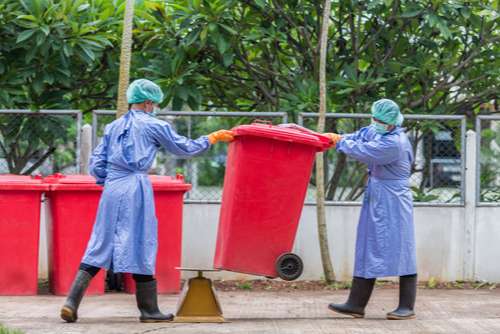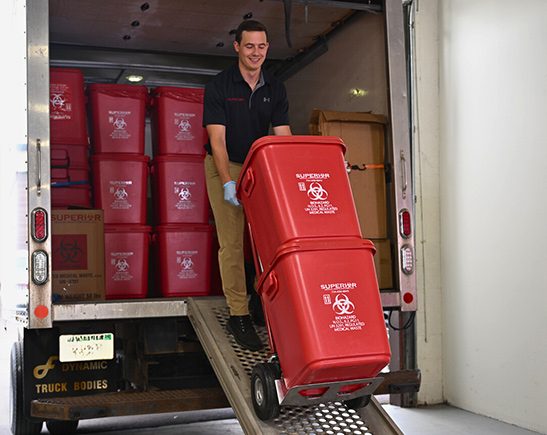Medical Waste Removal Quality: Elevating Security Specifications in Your Center
Medical Waste Removal Quality: Elevating Security Specifications in Your Center
Blog Article
Keep Ahead of Regulations: Professional Suggestions on Medical Waste Disposal
In a globe where the health care industry is continuously evolving, it is crucial for medical facilities to stay ahead of guidelines when it comes to the appropriate disposal of medical waste. From understanding the different categories of medical waste to implementing the appropriate collection and partition approaches, this conversation will certainly give workable pointers and beneficial understandings to help facilities remain ahead of regulations in the ever-changing landscape of medical waste disposal.
Comprehending Clinical Waste Categories
Recognizing clinical waste classifications is essential for appropriate disposal and administration in healthcare facilities. Clinical waste refers to any type of waste produced by medical care activities that might posture a danger to public health and wellness or the atmosphere. It is vital to categorize clinical waste properly to ensure its safe handling, disposal, transportation, and therapy.
There are several categories of medical waste that medical care centers need to be accustomed to. One of the most common categories include transmittable waste, pathological waste, sharps waste, pharmaceutical waste, and chemical waste. Each category has specific guidelines and guidelines for its correct management and disposal.
Pathological waste refers to human cells, organs, or body components that call for unique handling and disposal. Drug waste makes up run out, unused, or infected drugs that need mindful handling and disposal.
Staying Up-To-Date With Regulatory Adjustments
Staying current with regulative modifications is vital for health care centers to guarantee conformity and proper management of clinical garbage disposal. medical waste removal services. With policies regularly evolving, it is essential for health care centers to remain updated to avoid penalties, penalties, and potential injury to the atmosphere and public health and wellness
To stay ahead of governing modifications, health care facilities need to develop a system for tracking and tracking updates. This can be done by subscribing to regulative e-newsletters, going to workshops and meetings, and actively joining sector organizations. Additionally, centers must designate a personnel or group in charge of staying educated and disseminating details to relevant stakeholders.
Routine interaction with regulative firms is also vital. Health care centers should develop relationships with regional, state, and federal companies to guarantee they understand any kind of modifications in laws that might influence their waste management techniques. This can be done with routine meetings, participation in public comment periods, and positive interaction with governing agencies.
Furthermore, health care facilities need to take into consideration partnering with waste administration companies that concentrate on medical waste disposal (medical waste disposal services with WasteX). These business are frequently fluent in the current policies and can offer advice and assistance to guarantee conformity
Carrying Out Proper Collection and Partition Methods
To effectively take care of medical waste disposal, health care facilities should develop appropriate collection and segregation techniques based on governing standards. Applying these approaches makes certain the secure handling and disposal of possibly unsafe products, shields the setting, and lessens the danger of injuries and infections to medical care employees and the general public.
Appropriate collection and segregation methods involve the usage of marked containers and classifying systems. Medical care centers need to provide clearly labeled containers for various sorts of clinical waste, such as sharps, transmittable waste, pharmaceutical waste, and non-hazardous waste. These containers ought to be color-coded and clearly marked to avoid confusion and promote simple recognition.
Furthermore, health care facilities should train their staff on the right treatments for collecting and segregating medical waste. This consists of educating them on the different sorts of waste, the ideal containers to make use of, and the significance of complying with standards and regulations. Regular training sessions and correspondence course should be conducted to make medical waste disposal services with WasteX sure that employee remain updated on best methods.
In addition, healthcare centers need to develop a system for routine collection and disposal of clinical waste. This may include partnering with licensed waste administration business that concentrate on clinical garbage disposal. These business will make sure that the collected waste is moved and taken care of in conformity with regulative needs.
Choosing the Right Disposal Techniques

Incineration is just one of one of the most efficient and common methods for throwing away certain types of clinical waste, such as pathological waste and sharps. It entails the controlled combustion of waste at high temperature levels, reducing it to ash. Incineration can launch damaging pollutants right into the air and contribute to air contamination.

Other disposal techniques include chemical treatment, microwave therapy, and landfilling. Chemical therapy includes using chemicals to sanitize and reduce the effects of the waste. Microwave therapy utilizes microwave power to warmth and sanitize the Going Here waste. Landfilling involves burying the waste in a designated garbage dump location (medical waste disposal services with WasteX). Landfilling ought to be the last resort due to the potential danger of contamination to dirt and groundwater.
Guaranteeing Conformity Via Documentation and Training
After very carefully considering the proper disposal approaches for medical waste, medical care centers must make sure compliance with policies and decrease environmental influence by carrying out effective documents and training procedures. This step is essential in preserving a risk-free and sustainable atmosphere for both health care workers and the basic public.

Healthcare employees who take care of medical waste should get suitable training on waste partition, dealing with, and disposal treatments. By giving comprehensive training, healthcare centers can empower their staff to make informed decisions and reduce the danger of incorrect waste disposal.
Verdict
To conclude, staying in advance of regulations in medical garbage disposal is essential for health care centers. medical waste removal services. Recognizing the various categories of medical waste, staying updated with regulative adjustments, implementing proper collection and partition approaches, choosing the suitable disposal techniques, and making sure conformity via documentation and training are all vital actions. By complying with these guidelines, health care organizations can efficiently get rid of and take care of of clinical waste in a accountable and risk-free fashion
From recognizing the various categories of clinical waste to carrying out the ideal collection and partition techniques, this conversation will supply actionable suggestions and important understandings to assist centers stay ahead of guidelines in the ever-changing landscape of clinical waste disposal. - medical waste disposal services with WasteX
The most usual groups include transmittable waste, pathological waste, sharps waste, pharmaceutical waste, and chemical waste. Medical care centers must supply plainly identified containers for different types of medical waste, such as sharps, transmittable waste, pharmaceutical waste, and non-hazardous waste. Medical care facilities must develop a comprehensive system to videotape and track all aspects of medical waste disposal, including types of waste produced, quantities, and disposal methods used. Medical care workers who manage medical waste ought to receive ideal training on waste segregation, handling, and disposal procedures.
Report this page